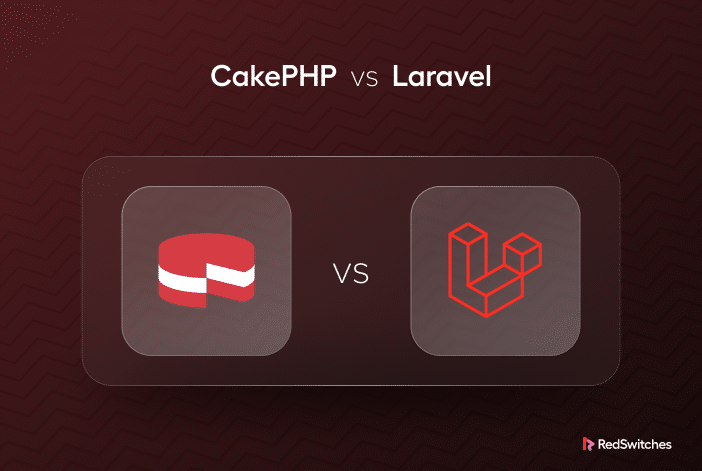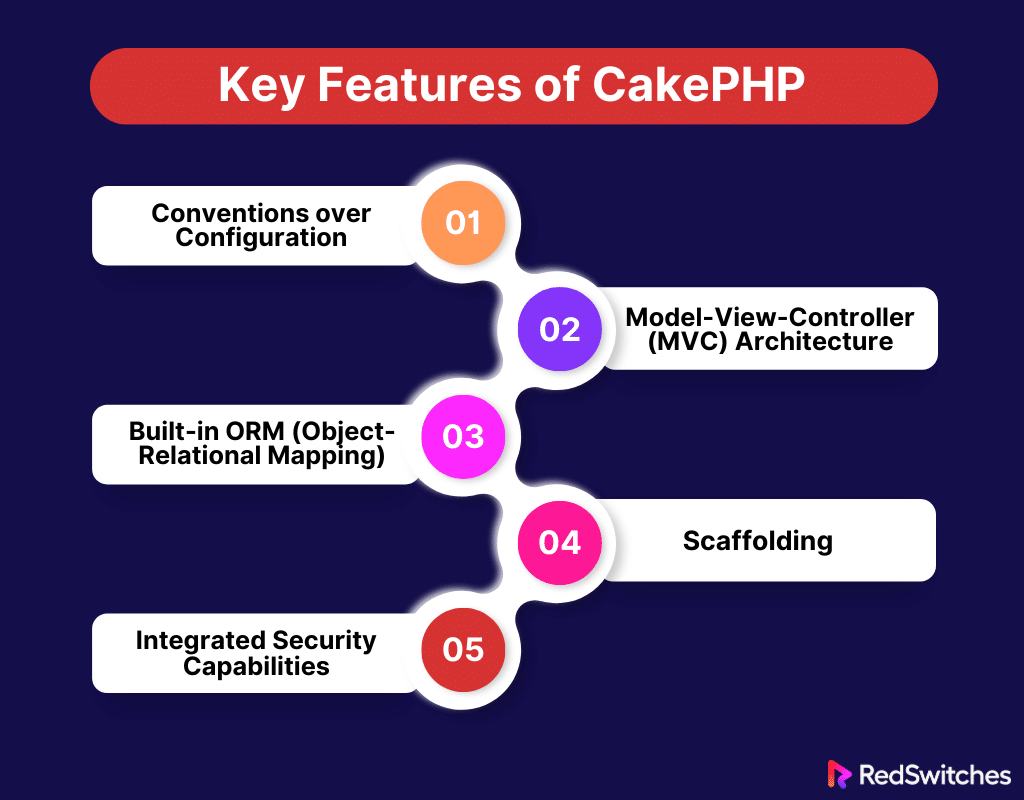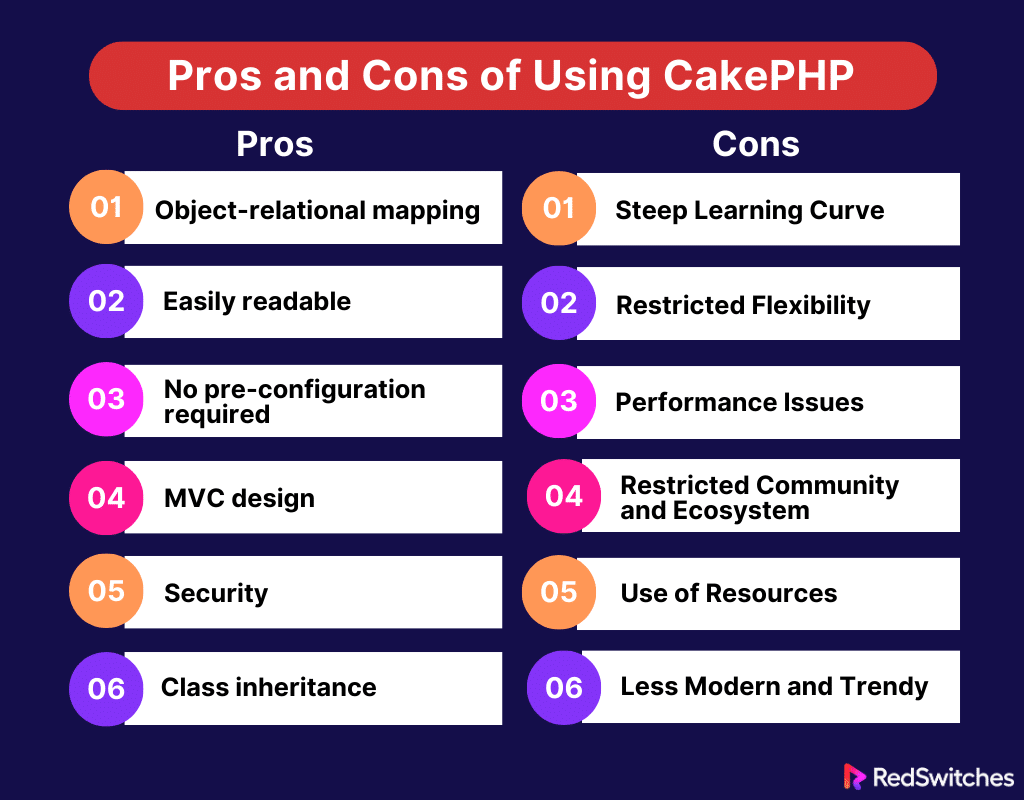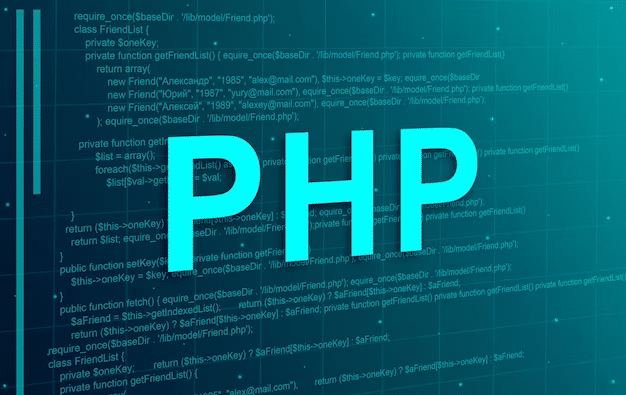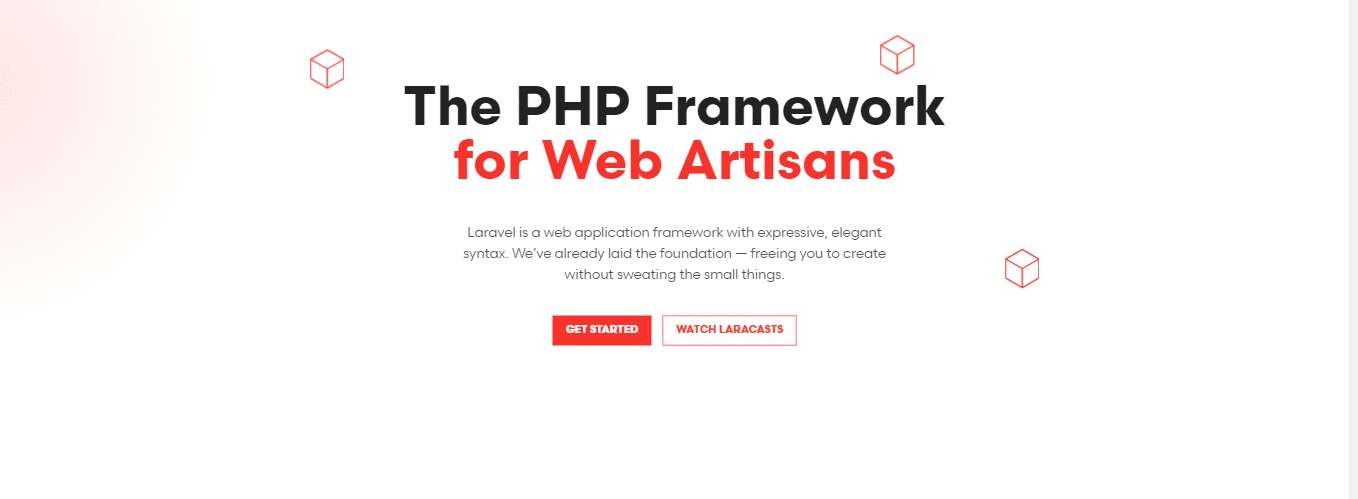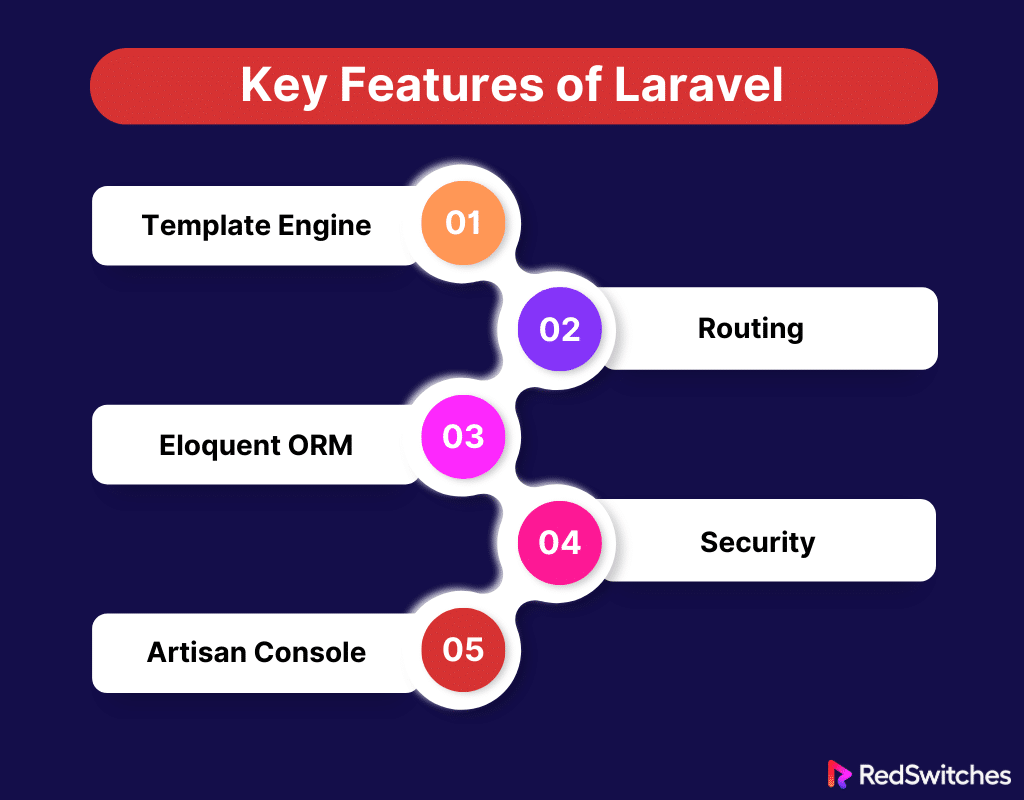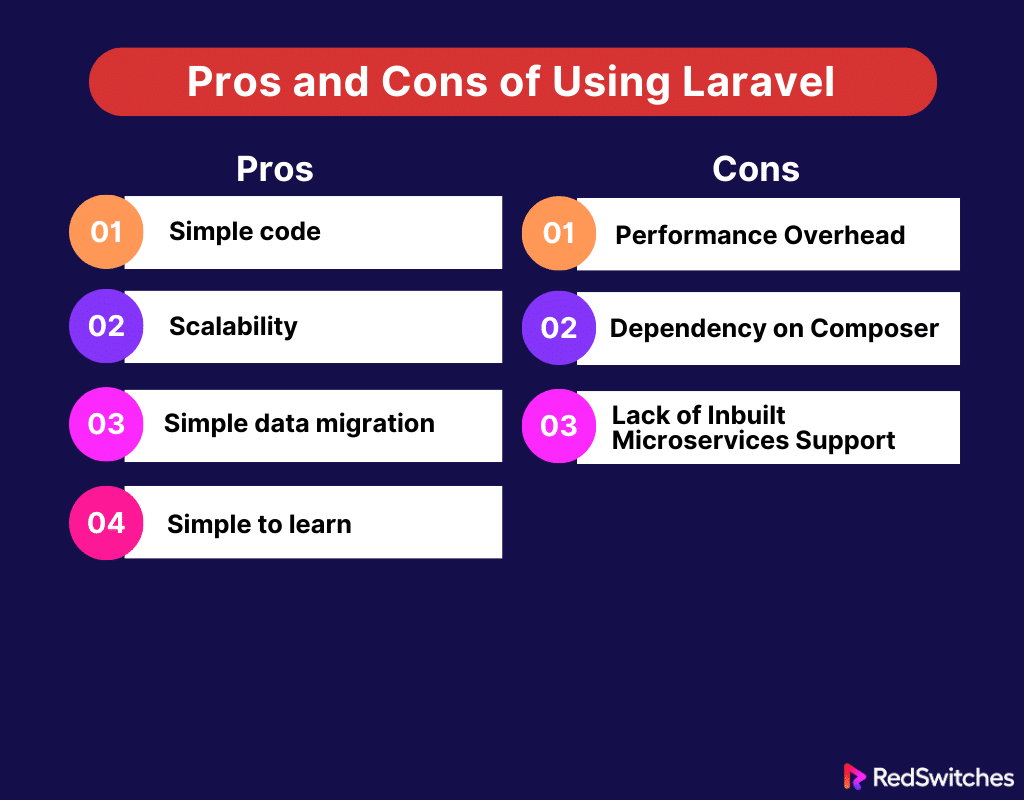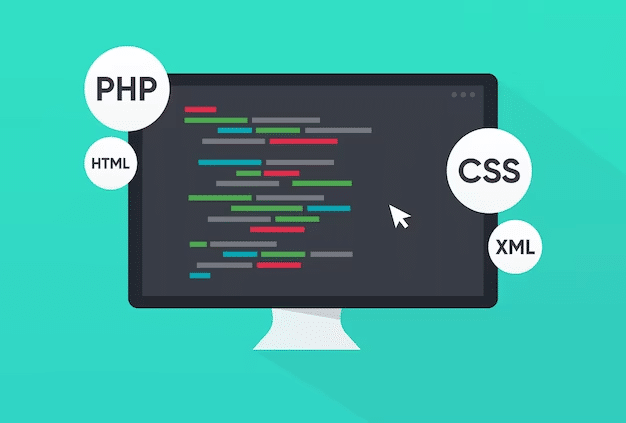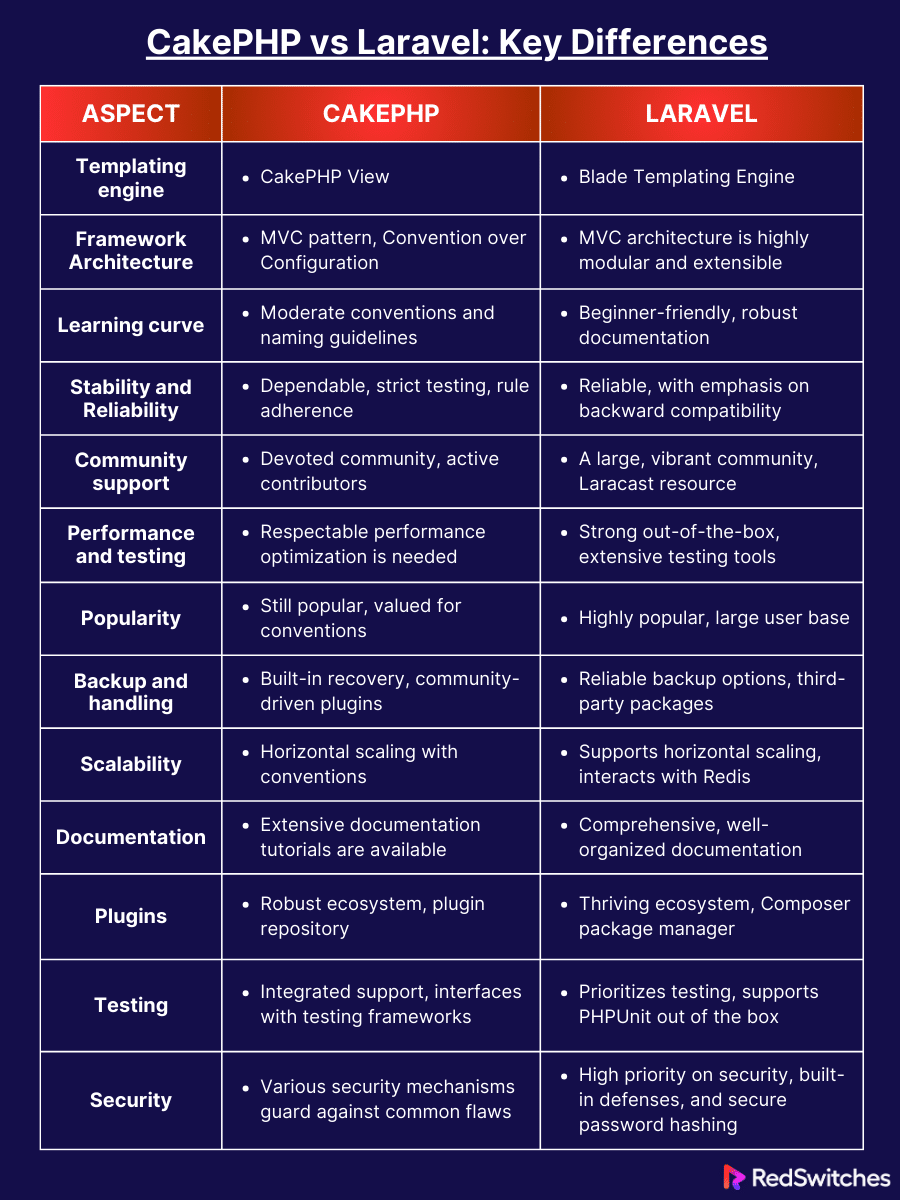The selection of a framework might be a crucial choice in the dynamic field of web development. Leading competitors CakePHP and Laravel both have distinctive advantages and traits. We examine 13 significant distinctions between these frameworks as we dig deeply into their core concepts in this enlightening blog post.
Making an informed decision requires knowing these differences, regardless of experience level as a developer or inexperience with coding. Come along as we explore the debate of CakePHP vs Laravel, giving you the knowledge and ability to choose the right solution for your web development projects.
Let’s Begin.
Table Of Contents
- What is CakePHP?
- What is Laravel?
- CakePHP vs Laravel: The Key Differences
- CakePHP vs Laravel: Templating Engine
- CakePHP vs Laravel: Framework Architecture
- CakePHP vs Laravel: Learning Curve
- CakePHP vs Laravel: Stability & Reliability
- CakePHP vs Laravel: Community Support
- CakePHP vs Laravel: Performance and Performance Testing
- CakePHP vs Laravel: Popularity
- CakePHP vs Laravel: Backup & Handling
- CakePHP vs Laravel: Scalability
- CakePHP vs Laravel: Documentation
- CakePHP vs Laravel: Plugins
- CakePHP vs Laravel: Testing
- CakePHP vs Laravel: Security
- When to Choose CakePHP for Your Project?
- When to Choose Laravel for Your Project?
- Conclusion
- FAQs
What is CakePHP?
Credits: CakePHP
An open-source PHP framework is called CakePHP. Its goal is to simplify significantly the creation, implementation, and management of applications. CakePHP is built upon a robust and intuitive MVC-style architecture. Models, views, and controllers ensure a rigorous but natural separation of business logic from the data and presentation layers.
It is typically used to manage online applications; Cake PHP’s extensive library support makes this vision evident and straightforward for developers to implement. Moreover, CakePHP’s run-time infrastructure framework makes things possible. Using Cake PHP typically results in fewer lines of code. It is one of the fastest web development platforms.
Michal Tatarynowicz created CakePHP in 2005; since then, regular updates have provided several fixes and upgrades. The most recent stable release was 3.7.9 in 2019. CakePHP’s MVC architecture separates business logic into multiple layers, resulting in clean and redundant code.
Key Features of CakePHP
These are some of CakePHP’s key features.
Conventions over Configuration
CakePHP adheres to the “convention over configuration” philosophy, which states that the framework infers configuration details from name conventions. As a result, a less explicit setting is required, which speeds up and simplifies development.
Model-View-Controller (MVC) Architecture
CakePHP follows the Model-View-Controller (MVC) architectural paradigm, dividing application logic into controllers, views, and models. This division helps with code organization, maintainability, and reusability.
Built-in ORM (Object-Relational Mapping)
A robust and user-friendly ORM framework included in CakePHP simplifies database interactions. It enables object-oriented terminology for database interaction, resulting in more understandable and expressive database-related code.
Scaffolding
Scaffolding is an automatic code-generation mechanism offered by CakePHP. It requires less boilerplate code because it enables developers to quickly implement their models’ basic CRUD (create, read, update, delete) capability.
Integrated Security Capabilities
CakePHP comes with built-in security capabilities that assist developers in preventing typical vulnerabilities in online applications. This provides safe password hashing, input validation, and CSRF prevention features.
Pros and Cons of Using CakePHP
After discussing the key features, let’s discuss the Advantages and disadvantages of using CakePHP.
Pros
Object-relational mapping, or ORM
This technique uses an object-oriented programming language to transform data between incompatible systems. Inside CakePHP is an ORM. Because of this, performing CRUD operations and working with databases is the easiest of all. Classes are used to convey data and help define relations and predefining callbacks. Version 2 and Version 3 are the two available versions; Version 3 supports PHP manager, while Version 2 does not.
Easily readable
PHP makes it possible to write reusable code that can be applied to multiple projects. Instead of adding more libraries, helpers, behavior, plugins, and components can all have the same capability. The Cake Forge website offers tools and plugin components, which reduce the work of typing everything.
No pre-configuration required
This implies no need to spend time setting up PHP, MySQL, and Apache on Linux. Cake PHP works independently by automatically identifying every configuration requirement. You don’t even need the Apache settings. It does this by managing built-in validation features, saving you time. Developers can design various validation policies.
MVC design
CakePHP relies on the Model View controller to distinguish between the data presentation layer and business judgment. Models use queries to join the database and save data there. While controllers produce data earlier, the view presents content to the end user in a viewable format and interacts with the database.
Security
It is one issue that development initiatives typically face. It can become secure in the user submission process faster because of its fundamental security and CRUD characteristics. Cake PHP comes with built-in security and authentication. It safeguards application security more than other frameworks. Additionally, it offers built-in features to prevent XSS, SQL injection, CSRF attacks, input validation, and form tampering.
Class inheritance
Appropriate class inheritance PHP inheritance is simple to comprehend. Each of its projects has two primary folders: the application-specific controllers, extensions of the app controller class, which is empty but can be readily extended with clever techniques like specified core functions, and the core library. The same held for models.
Cons
Steep Learning Curve
CakePHP’s complex conventions and customizations may challenge novice developers. It could be difficult for them to grasp the framework’s subtleties quickly.
Restricted Flexibility
Although CakePHP’s standards encourage uniformity, developers who prefer more freedom in their coding style may find them limiting. Any customization outside of these guidelines may require further work and workarounds.
Performance Issues
CakePHP occasionally performs less quickly than certain competing PHP frameworks, particularly when managing intricate or large-scale applications. This may be an issue for projects where achieving high performance is crucial.
Restricted Community and Ecosystem
CakePHP boasts a somewhat smaller community and ecosystem in contrast to certain other PHP frameworks. Fewer resources, like third-party plugins, extensions, and community-driven support, are available when a smaller community exists.
Use of Resources
There are occasions when CakePHP uses many resources, especially server resources. Projects with limited resources or those hosted on shared servers may find this to be an issue. High resource usage may not be the best choice for projects prioritizing cost-effectiveness and resource efficiency since it can raise hosting expenses.
Less Modern and Trendy
Within the ever-evolving field of web development, some perceive CakePHP as less cutting-edge and contemporary compared to more recent frameworks. Other frameworks can entice developers who want to work with cutting-edge technology and methodologies.
Popular Web Solutions Built with CakePHP
Credits: Freepik
After having a deep understanding of the advantages as well as disadvantages of CakePHP, we will now learn some of the popular web solutions built with CakePHP.
SnappyTV
CakePHP powers the backend operations of SnappyTV, a real-time video clipping and sharing platform. This ensures seamless video processing and content delivery. Because of its choice of framework, SnappyTV can provide customers with a seamless and responsive experience, establishing it as the preferred platform for sharing and consuming real-time video content.
Metro Bank
Using CakePHP for its online banking platform, Metro Bank, one of the top retail banks in the UK, allows users to do various banking operations quickly and safely. CakePHP’s solid foundation allows users to quickly and safely do various financial tasks.
Express Yourself
CakePHP powers the website for Express Yourself, a charitable organization that uses the creative arts to empower adolescents. It also helps with online fundraising, event planning, and content sharing. Because of the framework’s adaptability and dependability, Express Yourself may effectively use the internet’s power to promote charity endeavors. The organization can reach a larger audience and significantly improve the lives of teenagers thanks to CakePHP’s smooth integration.
Crowdcube
Using CakePHP to manage user accounts, investment procedures, and project management, Crowdcube is a well-known equity crowdfunding platform that offers a smooth experience to both investors and entrepreneurs. CakePHP is the foundation of Crowdcube’s platform, handling everything from user account management to investment processes and project management.
What is Laravel?
Credits: Laravel
Laravel is an open-source PHP framework that is dependable and simple to use. It adheres to the model-view-controller architecture paradigm. Laravel facilitates the creation of web applications by reusing pre-existing components from several frameworks. As a result, the web application is more logically organized.
Combining the fundamental elements of PHP frameworks such as Yii and CodeIgniter with those of other programming languages like Ruby on Rails, Laravel provides an extensive feature set. The extensive feature set of Laravel accelerates web development.
Key Features of Laravel
Template Engine
Blade is the name of the templating system included with Laravel. In addition to enabling you to write plain PHP code in your views, the blade offers useful shortcuts for basic operations like data presentation, form creation, and record pagination. These shortcuts include record pagination, data presentation, form construction, and directives for control structures (such as loops and conditionals).
Blade templates can be combined with conventional PHP code as needed, but they are turned into optimized PHP code for quicker rendering and better performance.
Developer productivity is increased by this advanced templating technology, which makes it simple to construct complex user interfaces with little code complexity.
Routing
Creating routes in your application is made simple and clear using Laravel. Through routing, you can associate URLs with particular activities, such as opening a page, contacting an API, or sending an email.
Eloquent ORM
The integrated Object Relational Mapper (ORM) in Laravel is called Eloquent. It offers a simple method for defining relationships between models and enables object-oriented database operations.
Security
Laravel has several security features, including user authentication, password hashing, and input validation.
Artisan Console
Artisan is a robust command-line tool that comes with WordPress that makes a variety of development jobs easier. For activities like database migrations, boilerplate code generation, seeding, and application environment management, Artisan offers a vast selection of functions.
Pros and Cons of Using Laravel
Let us understand the Pros and Cons of Laravel.
Pros
Simple code
Any web developer will tell you that coding is among the most challenging duties in web development. Using Laravel, the work becomes a lot easier. This is due to the software’s extensive library of pre-programmed features, which reduces the coding needed. As a result, utilizing the tools to create reliable web apps is simpler.
Scalability
Variations in project sizes. Depending on your needs, highly scalable software enables you to take on projects of any size. One such scalable framework that you can easily utilize for small- to medium-sized web projects is Laravel.
Simple data migration
In Laravel, data migration is simplified through the use of Artisan commands. Developers can easily generate migration files with predefined schemas, create tables, and seed data using the built-in migration and seeding features. This streamlined process ensures efficient database management and simplifies the initial setup of data structures in Laravel applications.
Simple to learn
Laravel is often regarded as one of the more approachable web frameworks by web professionals. That’s because the comprehensive user manual is readily available even in its most basic version. The software also comes with easily understood-PHP screencasts.
Cons
Performance Overhead
Because of its extensive feature set and appealing syntax, Laravel requires additional server resources. Compared to lightweight frameworks, the framework could provide unnecessary performance overhead for simple applications.
Dependency on Composer
A key element of Laravel is the PHP dependency manager Composer. However, managing dependencies can be difficult even when using Composer, especially when dealing with incompatible packages or version issues.
Lack of Inbuilt Microservices Support
Although Laravel is a fantastic framework for single-page applications, it might not be the most excellent choice for designing microservices. Additional third-party libraries and tools might be needed to develop and administer microservices.
Popular Applications Built with Laravel
Credits: Freepik
Before moving to the blog’s core, the ultimate CakePHP vs Laravel debate, let’s examine some popular Laravel applications.
Laracasts
Laracasts is a well-liked online learning resource for web developers, providing top-notch screencasts and video tutorials on web development subjects. It showcases the framework’s potential for learning platforms and is fully built on Laravel. Laracasts stands out due to its skillful use of the potent PHP framework Laravel for content development and delivery.
Laracasts illustrates the framework’s potential as a basis for learning platforms by utilizing Laravel’s powerful features. The platform’s appeal to web developers partly stems from its extensive content and the smooth user experience that Laravel’s sophisticated features enable.
World Walking
Users of this fitness and health app are encouraged to walk and work out while taking virtual trips around the globe. Because it is based on Laravel, the platform offers consumers a smooth and exciting experience.
CMS for October
October Based on Laravel, CMS is a potent open-source content management system. Because of its adaptable and user-friendly layout, it’s a well-liked option. Using Laravel’s robust features, October CMS offers a strong content management solution.
Its user-friendly design and adaptable features enable users to easily create, edit, and arrange material. Developers and content creators favor October CMS because of its smooth integration of Laravel, which guarantees a dependable and expandable platform.
CakePHP vs Laravel: The Key Differences
Credits: Freepik
Let’s understand the critical differences between CakePHP and Laravel.
CakePHP vs Laravel: Templating Engine
CakePHP
The first critical difference in the CakePHP vs Laravel argument is their templating engine.
CakePHP’s user-friendly, straightforward templating engine separates the presentation layer and application logic. With “CakePHP View,” its built-in templating language, developers may create dynamic and reusable templates.
It may not have all the sophisticated features seen in other templating engines, but it offers a simple method for processing data and displaying views.
Laravel
In contrast, Laravel uses the Blade templating engine. Blade is renowned for its graceful syntax, which enables programmers to create expressive templates with elements like sections and template inheritance.
Blade templates provide outstanding performance and versatility when compiled into standard PHP code. It is a favorite option for many Laravel developers due to its strength and simplicity.
CakePHP vs Laravel: Framework Architecture
Now let’s discuss the framework architecture point in our ultimate showdown of CakePHP vs Laravel
CakePHP
By adhering to the convention over configuration (CoC) philosophy, CakePHP offers developers a consistent and organized environment. It enforces name conventions to make the application’s architecture easier to navigate. The Model-View-Controller (MVC) pattern is the foundation for the framework’s architecture, guaranteeing a distinct division of responsibilities.
Laravel
With its sophisticated and expressive syntax, Laravel goes above and beyond the MVC architecture. A wide range of tools and components are available within the framework, including Artisan CLI for command-line tasks and Eloquent ORM for database interaction.
Because of its highly modular and extensible architecture, Laravel supports using design patterns like Dependency Injection.
CakePHP vs Laravel: Learning Curve
CakePHP
Newcomers may initially find CakePHP’s conventions and naming guidelines difficult. However, developers can readily create minimally configured applications once they understand these principles. The framework’s simplicity can benefit people who like clear-cut, dependable development techniques.
Laravel
Because of Laravel’s developer-friendly syntax and documentation, getting started is comparatively simpler for newcomers. In-depth documentation for the framework is available, as is Laracasts, a well-known online learning resource that includes tutorials and screencasts.
Laravel’s reputation as an approachable framework for beginners is largely due to its helpful community and teaching materials.
CakePHP vs Laravel: Stability & Reliability
What is the difference in Stability? Let’s understand the CakePHP vs Laravel debate in stability and reliability.
CakePHP
CakePHP is known for its dependability and stability. It has undergone numerous modifications and enhancements throughout its lengthy existence. CakePHP applications are reliable and strong because of their strict testing procedures and respect for rules.
Laravel
Despite being somewhat more recent than CakePHP, developers now trust Laravel because of its reliability. The framework is renowned for its emphasis on backward compatibility and frequent updates. Laravel’s increasing acceptance rate among corporations and enterprises is indicative of its dedication to offering a dependable platform.
CakePHP vs Laravel: Community Support
CakePHP
The community at CakePHP is devoted and helpful. CakePHP aficionados actively contribute to forums, GitHub repositories, and community-driven plugins; however, their numbers may not be as great as those of Laravel’s community. The collaborative nature of the community guarantees that developers can stay updated with the newest developments in CakePHP development and solve difficulties.
Laravel
One of its best features is the community support for Laravel. Thanks to a large and vibrant community, Developers can access many tools, such as online tutorials, forums, and open-source packages. The fervor and eagerness of the community to exchange expertise render Laravel a compelling option for developers in search of support and cooperation.
CakePHP vs Laravel: Performance and Performance Testing
Let’s discuss the CakePHP vs Laravel performance in this section.
CakePHP
CakePHP offers respectable performance for the majority of uses. Its performance can be enhanced by adhering to recommended practices, like caching, database indexing, and code optimization. Despite not being the fastest PHP framework, it performs well enough for various applications.
Laravel
Laravel has robust architecture and good performance right out of the box. It also has attractive syntax. The speed and efficiency of the framework are improved by features like opcode caching, Eloquent ORM optimizations, and query caching. Applications built using Laravel can manage many requests per second, making them appropriate for websites and applications with heavy traffic.
CakePHP vs Laravel: Popularity
CakePHP
Developers that value CakePHP’s conventions and simplicity are among its devoted user base. CakePHP is still a popular choice for many web development projects, especially those prioritizing ease of use and rapid development, even though it may not be as heralded as some of the more recent frameworks.
Laravel
Since its launch, Laravel’s popularity has increased dramatically. Many developers and companies use it as one of the most well-liked PHP frameworks, a popular choice for projects.
Laravel is a leading option in PHP because of its developer-friendly methodology, copious documentation, and vibrant community.
CakePHP vs Laravel: Backup & Handling
CakePHP
CakePHP comes with built-in data recovery and backup options. Developers can use versioning and database backups by utilizing CakePHP’s ORM features. Furthermore, backup options are frequently included in CakePHP’s community-driven plugins, giving developers options based on their unique needs.
Laravel
Using libraries and third-party packages, Laravel provides reliable backup options. Simple-to-use solutions for backing up files, databases, and cloud storage are available in packages like Spatie’s Laravel Backup. Laravel’s ability to integrate with widely used cloud storage services improves its backup capabilities and guarantees the integrity and safety of data.
CakePHP vs Laravel: Scalability
CakePHP
Applications built with CakePHP can be horizontally scaled by distributing them over several servers. CakePHP can manage moderate to high traffic volumes well, though it may need some extra configuration for horizontal scaling. Because the framework follows conventions, scaling is made easier, and developers may concentrate on optimizing application logic.
Laravel
Scalability is a priority in the design of Laravel apps. Because the platform lets developers split up work and processes among several servers, facilitating horizontal scaling. Laravel handles large-scale projects and demanding workloads better because of its interaction with solutions like Redis for caching and queue management.
CakePHP vs Laravel: Documentation
Let’s understand the CakePHP vs Laravel argument regarding Documentation.
CakePHP
Extensive documentation on all facets of the framework, such as installation, configuration, and best practices, is provided by CakePHP. The documentation is helpful for novice and seasoned developers because it offers concise explanations and examples. To help developers with their projects, CakePHP’s website also offers tutorials, instructions, and API references.
Laravel
Laravel is widely known for its comprehensive and well-organized documentation. From fundamental ideas to sophisticated functionalities, every facet of the framework is thoroughly covered in the official Laravel documentation.
It gives developers the tools to understand and successfully use Laravel’s features through code examples, explanations, and best practices. Since it sets a high bar for accessibility and lucidity, other frameworks frequently use Laravel’s documentation as a model.
CakePHP vs Laravel: Plugins
CakePHP
The community has created a robust ecosystem of plugins for CakePHP. These plugins cover numerous features like database administration, caching, and authentication. The official CakePHP website has a plugin repository, which makes it easier for developers to find and include plugins in their work. Plugin availability improves CakePHP’s flexibility and extensibility.
Laravel
The Composer package manager provides access to a thriving Laravel package and plugin ecosystem.
Packages that cover a range of requirements, including social network integration, payment gateways, and authentication, are actively contributed to by the Laravel community. High-quality packages are readily available, which expedites project completion times and simplifies development duties.
With the help of Composer’s dependency management and Laravel’s package ecosystem, developers can quickly improve their apps.
CakePHP vs Laravel: Testing
CakePHP
CakePHP has integrated integration and unit testing support. The testing components of the framework let developers create test cases, make assertions, and mimic HTTP requests. With CakePHP’s testing tools, developers can ensure their apps are correct and identify problems before deployment.
Furthermore, CakePHP interfaces with widely used testing frameworks, making it easier for applications to have thorough test coverage.
Laravel
Laravel prioritizes testing and gives developers access to a stable testing environment. The framework provides easy ways to write unit tests, feature tests, and HTTP tests, and it supports PHPUnit out of the box. By using testing features like mocking, database seeding, and assertions provided by Laravel, developers can create thorough tests for their apps.
CakePHP vs Laravel: Security
Security is primary to any big organization. Let’s understand the security aspect in the CakePHP vs Laravel debate.
CakePHP
CakePHP has several security mechanisms to shield apps against frequent security flaws. It can prevent SQL injection, validate data, and guard against cross-site scripting attacks (XSS).
The ORM in CakePHP automatically guards against SQL injection, improving database interactions’ security. The framework’s security component ensures strong security protections for CakePHP applications, which provides techniques for data sanitization, form tampering protection, and safe password hashing.
Laravel
Laravel places a high priority on security and comes with many capabilities to protect apps from attacks. The framework has built-in defenses against attacks such as cross-site request forgery (CSRF) and cross-site scripting (XSS).
Prepared statements are used by Eloquent, the ORM from Laravel, to provide security against SQL injection. Furthermore, Laravel ensures user password secrecy by supporting secure password hashing using the Bcrypt technique.
Let’s summarize the differences through a table.
Also Read: Laravel vs Angular: Decoding the Web Development Duel
When to Choose CakePHP for Your Project?
After discussing the in-depth debate of CakePHP vs Laravel, we will now discuss the circumstances when Choosing CakePHP will be ideal.
Rapid Development
CakePHP’s convention over configuration (CoC) approach might be a blessing if your project requires rapid development without being mired in intricate configurations. Thanks to its preset naming standards and readily usable components, developers can concentrate on creating features instead of wasting too much time on setup and configuration.
Budget Restrictions
CakePHP is an excellent option for projects with a tight budget. You may produce reliable apps despite limited resources because of their simplicity and quick development speed. Because it often results in cost savings, the shorter development time makes it a desirable choice for startups and small businesses.
Small to Medium-Sized Projects
CakePHP works well for small to medium-sized applications where the framework’s simplicity matches the project’s needs.
When to Choose Laravel for Your Project?
Contemporary Web Apps
Laravel is a great option for creating cutting-edge, feature-rich web applications. The construction of complicated web applications can be made simpler by using Laravel’s expressive syntax and powerful tools, especially if your project calls for real-time updates, interactive user interfaces, and advanced functionality.
Big and Scalable Projects
Laravel is ideal for large-scale projects with a lot of traffic and databases since it is very scalable. It is recommended for applications with expanding user bases and rising data volumes because of its strong architecture, support for horizontal scaling, and integration with caching technologies.
Productivity of Developers
Laravel is made to improve developers’ productivity. Its beautiful syntax, pre-built tools, and large library can speed up the writing process if your project requires rapid development.
Conclusion
We’ve gone deep into the details of both frameworks in the debate between CakePHP vs Laravel, learning about their definitions, salient characteristics, advantages, and disadvantages. Examining the 13 key distinctions between Laravel and CakePHP, it is clear that each framework has special advantages that meet a range of development requirements.
The decision ultimately comes down to the requirements of your project, whether you value Laravel’s elegance and vast ecosystem over CakePHP’s simplicity and convention-driven approach.
While selecting, consider RedSwitches dependable hosting options to ensure your framework works well in a stable hosting environment.
Making an informed decision and selecting the best hosting partner will help you develop outstanding web apps customized to meet your unique requirements.
FAQs
Q. What’s the difference between CakePHP and Laravel?
CakePHP prioritizes convention-driven development and simplicity, whereas Laravel provides elegance, an extensive feature set, and a robust ecosystem.
Q. Which is better than Laravel?
It depends on the needs of your project; both CakePHP and Laravel have their advantages; therefore, the decision should align with your particular needs.
Q. What is the difference between Laravel Codelgniter and CakePHP?
CodeIgniter is about speed and simplicity, Laravel is about elegant syntax and sophisticated functionality, and CakePHP is about convention-driven development and quick prototyping.
Q. Which framework is superior for simplicity and quick development?
CakePHP is well known for its convention-driven approach and simplicity, which makes it perfect for quick development. Its integrated scaffolding and code generation features further enhance the development speed.
Q. Which framework is more actively and broadly supported by the community?
A large and vibrant community exists for Laravel, providing developers with tools and assistance. Laravel’s extensive documentation, frequent updates, and a rich ecosystem of packages contribute to its strong community support.
Q. What is the difference between CakePHP and Laravel?
CakePHP and Laravel are both PHP frameworks for web development, but they have differences in terms of their features, syntax, and performance.
Q. Which is better for web development, Laravel or CakePHP?
Laravel is considered to be a more modern and feature-rich framework compared to CakePHP, making it a preferred choice for web development.
Q. What are the advantages of CakePHP?
CakePHP provides a hierarchical model-view-controller (MVC) architecture, ease of use, and it is a free, open-source framework, making it suitable for rapid application development.
Q. What are the advantages of using Laravel?
Laravel offers benefits such as being an open-source MVC PHP framework, having a modern and expressive syntax, and providing a wide range of tools and features for web development.
Q. Are there any key differences between Laravel and CakePHP?
Yes, the differences include the licensing (CakePHP is free to use, while Laravel is open-source), syntax, and the range of features provided by each framework.
Q. Which framework is more commonly used in the industry, Laravel or CakePHP?
Laravel is more commonly used due to its modern features and robust development tools, making it a popular choice among developers for web applications.
Q. What is the experience in using Laravel compared to CakePHP?
Many developers find Laravel offers a more streamlined and enjoyable development experience compared to CakePHP, especially for complex web applications.
Q. Is CakePHP or Laravel better for building enterprise-level applications?
Laravel is often preferred for building enterprise-level applications due to its extensive features, better performance, and robust ecosystem.
Q. Does CakePHP offer similar features to Laravel?
While CakePHP provides features similar to Laravel, the latter is often considered to have more advanced features, a modern syntax, and better development tools for web applications.
Q. Are there any notable differences in the licensing requirements between Laravel and CakePHP?
Yes, CakePHP is free to use, whereas Laravel is open-source and does not require a license for use.
